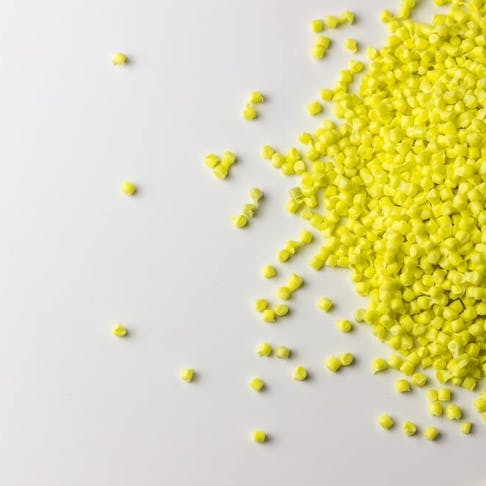Thermoplastic elastomers (TPEs), also known as thermoplastic rubber, are materials that have the properties of thermoplastics. They also have the flexibility and elasticity of materials like rubber and polyurethane. These properties make TPE ideal for applications that require both mechanical strength and flexibility. TPEs can be melt-processed using standard thermoplastic processing equipment, including injection molding, extrusion, and blow molding. This makes them suitable for high-volume manufacturing across various industries, including automotive, medical, consumer goods, electronics, and more.
This article explores what TPEs are, how they are synthesized, the types and grades commonly used in industry, the performance advantages and limitations of the material, as well as its safety and toxicity profile. This article will describe what TPEs are, how they are made, the typical grades available, and the advantages/disadvantages of using this material.
What Are Thermoplastic Elastomers (TPEs)?
A thermoplastic elastomer (TPE) refers to any polymer that has elastic or rubber-like behavior. TPEs extend or compress when exposed to a load and will return to their original shape after the load is removed. Thermoplastic polymers can be formed using melt-processing techniques such as injection molding, blow molding, or 3D printing. As the plastic cools, it hardens and does not require curing, unlike thermosetting elastomers. Many TPEs can be melted and recycled. TPEs are therefore easy to process while retaining the properties familiar with thermosetting elastomers. Thermoplastic elastomers have a molecular structure made up of hard and soft segments as described below:
- Hard Segments: Typically crystalline in nature, these hard segments contribute to the material's plastic-like behavior. These segments are responsible for properties like melting temperature, chemical resistance, and tensile strength.
- Soft Segments: Typically amorphous in nature, these segments give the material its elastomeric properties, like flexibility, hardness, and permanent set.
How Are Thermoplastic Elastomers (TPEs) Made?
TPEs are chemically synthesized through polymerization techniques such as block copolymerization and graft copolymerization. These processes involve combining two or more monomers to produce a material with both hard and soft segments, which are essential for TPE’s unique properties. In these copolymers, one monomer typically forms rigid, crystalline (or semi-crystalline) domains, providing strength and structural integrity. The other monomer forms soft, amorphous domains that impart flexibility and elastomeric behavior. This phase separation between hard and soft segments is what enables TPEs to exhibit both thermoplastic processability and rubber-like elasticity.
The two primary polymerization techniques used in TPE synthesis are:
- Block Copolymerization: This method produces polymers with alternating "blocks" of hard and soft segments arranged along a linear backbone. The block architecture enables microphase separation, contributing to the material's thermoplastic and elastomeric properties.
- Graft Polymerization: In this technique, polymer chains (side branches) are grafted onto a central polymer backbone. This approach offers greater architectural flexibility, allowing independent variation of the hardness and elasticity by altering the composition of both the backbone and the side chains.
What Are the Types of Thermoplastic Elastomers (TPEs)?
There are many different grades of TPE material; however, listed below are the most commonly used types of TPE:
- Styrenic Block Copolymers (TPE-S): Used in footwear and seals, and is one of the most widely used TPEs.
- Thermoplastic Polyolefins (TPO): Typically used in applications where standard polypropylene is not sufficient in terms of toughness.
- Thermoplastic Vulcanisates (TPV): A specially prepared mixture of EPDM (ethylene propylene diene monomer) and PP (polypropylene). This type of TPE has high-temperature resistance of up to 120 °C and is used for automotive seals.
- Thermoplastic Polyurethanes (TPU): This material exhibits excellent abrasion and tear resistance, as well as good rebound resilience.
- Thermoplastic Copolyesters (TPE-E): Have an excellent temperature resistance of up to 140 °C, one of the highest possible with TPE material. TPE-E also has excellent chemical resistance.
- Melt-Processable Rubber (MPR): Designed to replace nitrile rubber and, as such, has excellent resistance to oils and grease. MPR also shares other properties with standard rubber, like good stress relaxation properties and good rebound resilience.
- Thermoplastic Polyether Block Amides (TPE-A): Have good high-temperature resistance and can be bonded to polyamide (nylon) thermoplastics.
For more information, see our article on Types of Thermoplastic Elastomers.
What Are the Uses of Thermoplastic Elastomers (TPEs)?
TPEs are utilized in various applications that can specifically benefit from their unique combination of rubber-like elasticity and thermoplastic processability. Some typical TPE products and their associated industries are listed below:
- Consumer Products: Blenders, cell phone covers
- Automotive: Seals, car mats, interior panels, airbag covers, shock dust boots
- Food and Beverage: Food containers, water bottles
- Medical: Flexible tubing, dental polishers, oxygen masks (TPEs used in this sector must meet biocompatibility standards such as ISO 10993 or USP Class V)
- Industrial: Seals, bushes, vibration isolation mounts
- Sportswear: Helmets, swimming fins, snorkels, shoe soles
- Pet Products: Toys, feeding bowls, transport kennels
- Electronics: Cable insulation, plugs
- Power tools: Soft tool grips

What Are the Advantages of Thermoplastic Elastomers (TPEs)?
Thermoplastic elastomers (TPEs) have the processability of thermoplastics and the flexible properties of elastomers. Listed below are some TPE material properties:
- Low-Energy Production: Thermoset and vulcanizing processes require high amounts of energy for manufacturing. TPEs, on the other hand, require less energy, making them more energy-efficient.
- Recyclable: Like other thermoplastics, TPEs can be remelted and reused, thereby making them recyclable.
- Favorable Mechanical Properties: TPEs have many of the mechanical properties of high-performance elastomers. As such, they have excellent flexural strength, good fatigue strength, and excellent abrasion resistance.
- Melt Processable: One of the primary benefits of TPE is its suitability for typical melt-processing techniques, such as injection molding. This means that high-volume and low-cost parts can be made from materials that were historically only possible with expensive and complex thermosetting and vulcanizing processes.
- Easily Colored: Dyes and pigments readily affect TPEs. As such, they can be made into a wide array of colors.
What Are the Disadvantages of Thermoplastic Elastomers (TPEs)?
Despite excellent thermoplastic elastomer properties, TPEs also have some key disadvantages as listed below:
- Hygroscopic: TPEs tend to absorb moisture and, as such, need to be sufficiently dried before processing.
- Melting: The TPE melting point is low, and as such, TPEs are melt-processable using standard thermoplastic techniques. However, TPEs can be permanently damaged if heated past the degradation temperature of the soft segments in the polymer. This limits their high-temperature applications.
- High Hardness: TPEs are generally harder than other elastomers, like rubber or polyurethane. This is in part due to the inclusion of thermoplastic hard segments within the polymer. Hardnesses are typically 80 Shore A and above.
Safety and Toxicity Profile of Thermoplastic Elastomers (TPEs)
TPEs are widely considered non-toxic and safe for use in consumer, medical, and industrial applications when properly formulated. In their base form, TPEs are chemically stable, free from vulcanizing agents, and can be processed without generating hazardous byproducts under standard conditions. Food-contact and medical-grade TPEs are available and manufactured to comply with relevant standards, including FDA 21 CFR, EU 10/2011, ISO 10993, and USP Class VI. These grades undergo migration and biocompatibility testing to ensure safety in regulated environments.
Most modern TPE formulations are phthalate-free, BPA-free, and compliant with RoHS and REACH directives. They are also hypoallergenic and free from latex proteins, making them suitable for skin-contact applications. However, material safety depends on the full formulation—confirmation through supplier documentation is advised.
TPEs are thermally stable within their processing limits, but excessive heat can cause degradation and release minor VOCs. Standard ventilation is recommended during manufacturing. In addition to their safety profile, TPEs are recyclable, offering environmental benefits over traditional thermoset elastomers.
Frequently Asked Questions About Thermoplastic Elastomers
Can Thermoplastic Elastomers Be Recycled?
Yes, thermoplastic elastomers (TPEs) are recyclable because they can be melt-processed without undergoing significant chemical degradation. This property enables the mechanical granulation and reprocessing of unused or scrap TPE material for use in molding or extrusion applications. However, the recyclability of TPEs depends on their specific formulation, the presence of additives, and whether they are blended with other materials.
Summary
This article provided a look at Thermoplastic Elastomer materials, including the types, uses, applications, method of production, and toxicity. To learn more about the various thermoplastic elastomers applications and how best to use TPE material to meet your unique requirements, contact one of our application engineers or material specialists for assistance.
Disclaimer
The content appearing on this webpage is for informational purposes only. Xometry makes no representation or warranty of any kind, be it expressed or implied, as to the accuracy, completeness, or validity of the information. Any performance parameters, geometric tolerances, specific design features, quality and types of materials, or processes should not be inferred to represent what will be delivered by third-party suppliers or manufacturers through Xometry’s network. Buyers seeking quotes for parts are responsible for defining the specific requirements for those parts. Please refer to our terms and conditions for more information.


